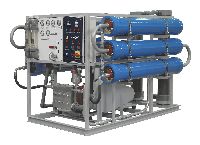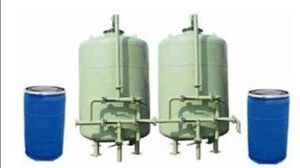
Ultraviolet Water Sterilizer
Tescon disinfection process Ultraviolet(U.V.) disinfection of water consists of a purely physical, chemical-free process. UV-C radiation in particular, with a wavelength in the 240nm to 280 nanometers range, attacks the vital DNA of the bacteria directly The radiation initiates a photochemical reaction that destroys the genetic information contained in the DNA. The bacteria lose their reproductive capability and are destroyed. Even parasites such as Cryptosporidia or Giardia, which are extremely resistant to chemical disinfectants, are efficiently reduced. UV can also be used to remove chlorine and chlormaine species from water this process is called photolysis, and requires a higher dose than normal disinfection. The sterilized microorganisms are not removed from the water. UV disinfection does not remove dissolved organics, inorganic compounds or particles in the water. However, UV-oxidation processes can be used to simultaneously destroy trace chemical contaminants and provide high-level disinfection.
...more
Reverse Osmosis Plant
“Reverse Osmosis (R.O.) is the most economical method of removing 95% to 99% of all contaminants. The pore structure of R.O. Membranes is much tighter than that of UF membranes. RO membranes are capable of rejecting practically all particles, bacteria and organics>200 Dalton molecular weight (including pyrogens) at a rate close to 99%. Natural osmosis occurs when solutions with two different concentrations are separated by a semi-permeable membrane. Osmotic pressure drives water through the membrane; the water dilutes the more concentrated solution, and the end result is equilibrium. In water purification systems, hydraulic pressure is applied to the concentrated solution to counteract the osmotic pressure. Pure water is driven from the concentrated solution at a flow rate proportional to applied pressure and colleted downstream of the membrane. RO also involves an ionic exclusion process. Only solvent (i.e. water molecules) is allowed to pass through the semi-permeable RO membrane, while virtually all ions and dissolved molecules are retained (including salts and organic molecules such as sugars). The semi-permeable membrane rejects salts (ions) by a charge phenomenon action: the greater the charge, the greater the rejection. Therefore, the membrane rejects nearly all (>99%) strongly ionized polyvalent ions but only 95% of the weakly ionized monovalent ions like sodium. Salt rejection increases significantly wit applied pressure up to 5 bar.”
...more
Ozone Generators
The formation of oxygen into ozone occurs with the use of energy. This process is carried out by an electric discharge field as in the CD-type ozone generators (corona discharge simulation of the lightning), or by ultraviolet radiation as in UV-type ozone generators (simulation of the ultraviolet rays from the sun). In addition to these commercial methods, ozone may also be made through electrolytic and chemical reactions. In general, an ozonation system includes passing dry, clean air through a high voltage electric discharge, i.e., corona discharge, which creates and ozone concentration of approximately 1% or 10,000 mgL. In treating small quantities of waste, the UV ozonators are the most common, while large-scale systems use either corona discharge or other bulk ozone-producing methods.
...more
Micron Filters
Microfiltration cartridge Filtration is a filtration process which removes contaminants from a fluid (liquid & gas) by passage through a microporous membrane. A typical microfiltration membrane pore size range is 0.1 to 10 micrometres (µm). Microfiltration is fundamentally different from reverse osmosis and nanofiltration because those systems use pressure as a means of forcing water to go from low pressure to high pressure.
...more
electronic dosing pump
Solenoid pumps are the simplest, because they have the fewest moving parts. Timing circuitry energizes an electromagnet, which slides the diaphragm into the discharge position. The magnet moves against both back pressure and a spring. When the magnet is de-energized, it drives the diaphragm mechanism backward into the suction position. Diaphragm pumps pulse a flexible diaphragm to displace liquid with each stroke. Diaphragm pumps deliver their fluid with a high degree of pulsation. There are several diaphragm pump categories, including solenoid, mechanical and hydraulic.
...more
Dosing Pumps
Metering / Diaphragm pumpsDiaphragm pumps pulse a flexible diaphragm to displace liquid with each stroke.Diaphragm pumps deliver their fluid with a high degree of pulsation.There are several diaphragm pump categories, including solenoid, mechanical and hydraulic.Solenoid pumps are the simplest, because they have the fewest moving parts. Timing circuitry energizes an electromagnet, which slides the diaphragm into the discharge position. The magnet moves against both back pressure and a spring. When the magnet is de-energized, it drives the diaphragm mechanism backward into the suction position. Special Features:Different Ranges: F-55 (5 lph @ 5bar), AMS-180 (180 LPH@0 Bar)Enclosure: IP – 65 Protection, Moc - PPStrokes Frequency: 150 spm. (max.)All Liquid Ends MoC: PVDF (standard)All O-rings: VitonDiaphragm: PTFEValve Body: PVDFBalls: CeramicHigh Grade Semiconductor PCB with SMD TechnologyHigh Grade Solenoid (MoC – SS)Pumps comes with CE, UL & WQA Certifications Feature – Benefits Sl.no. Features Benefit1).All liquid ends are in PVDF High Resistance to chemicals2).All O-rings used are of Viton Ensure Leak proof operations3).Solenoid in SS Ensure longer life4).PCB Circuit Board made with Ensures longer life and less SMT(Surface mount) chances of short circuit is PCB5).Enclosure is IP65 Protection Ensure good operations in differentEnvironmental conditions6).Constant, 1/10 Directly go to low volumes without Affecting solenoid efficiency7).Strokes Frequecy: 150 spm(max) Highly precise operations Dosing pumps Applications:Water Treatment IndustryChemical ProcessingLaboratory DispensingFactors—such as chemical compatibility, media viscosity, temperature, flow rates and pressure—determine which metering pump best fits a specific application.
...more
DM Plant
Industrial DM plants consists of cation unit and anion unit placed one after other in series. The cation unit is charged with strong acid cation resin & anion unit is charged with strong base unit. Industrial DM plants remove all the anions & cations from the water. Conductivity of the treated water at the out let of Industrial DM Plant shall be less than 1 micro mhos per cm. The cation resin is regenerated with Hydrochloric acid & anion resin with Caustic solution. Industrial Mixed Bed DM Plant is called as polisher. Two bed DM Plant out let Conductivity will be less than 30 micro mhos, this 30 will be bring down in Mixed bed DM plant. Air is required in Mixed Bed DM plant to mix resins after regeneration. Industrial DM plant vessels are made up of Mild steel rubber lining. Industrial DM Plants are used in the following areas.
...more
desalination

Drinking Water Plant

Iron Removal

Micron Filter
Microfiltration cartridge Filtration is a filtration process which removes contaminants from a fluid (liquid & gas) by passage through a microporous membrane. A typical microfiltration membrane pore size range is 0.1 to 10 micrometres (µm).
...more
Ozonator
Tescon has a wide range of Ozonators, starting from 1 gram ozonator to 2000 grams ozonators. We supplied number of ozonators to swimming pools, textile industries, pharmaceuticals and mineral water plants.
...more
Reverse Osmosis Plants
Tescon Aqua Tech offers a wide range of reverse osmosis plants from India.
...more
Industrial Water Softeners
Tescon Aqua Tech offers a wide range of softening plants with versatility in flow, flexibility in resin quantities and ease in operation. Tescon is one of the leading manufacturers of water softeners in India.
...more
Water Treatment Plants
We have handled a wide variety of Water Treatment applications including Water Softening Plants, Demineralised Water Plants, Reverse Osmosis Plants, Mineral Water Plants, etc.
...more
Mineral Water
We provide mineral water plants that upgrade the quality of drinking water. Through our mineral water plants we are able to determine the impurities(minerals) in water and make water drinkable by removing the impurities.
...more
Chemical Storage Tanks
A chemical storage tank is mounted on its own stand and connected to the skid with either hard PVC piping or quick disconnect fittings and flexible hoses.
...more
Commercial RO Water Treatment Plants
We offer commercial ro water treatment plants. Tescon commercial ro water treatment plants are used the reverse osmosis principle to treat water and makes it to suitable for commercial purposes. The commercial ro plants are the most cost effective water treatment plants for any commercial establishments.
...more
Industrial DM plants
We offer industrial dm plants. Industrial dm plants consists of cation unit and anion unit placed one after other in series. The cation unit is charged with strong acid cation resin & anion unit is charged with strong base unit. Industrial dm plants remove all the anions & cations from the water.
...more
Industrial Ro Plant
TESCON presents a small and medium capacity Industrial RO Plant model TAT 5KL series, which are ideal for small and medium Industrial organizations, which require an output ranging from 100 gallons per day to 6000 gallons per day.
...more
industrial softeners
Industrial Softeners are manually operated and designed to suite the requirements of medium scale industries. They incorporate the proven technique of counter flow regeneration. The Industrial Softeners thus produce treated water with low residual hardness throughout the cycle.
...more
Packaged RO Plant
We offer packaged ro plant. Tescon packaged reverse osmosis systems are typically used whenever salt removal or deionization is required. Packaged reverse osmosis removes more than 97%-99% of the total dissolved solids along with organics, bacteria and other particulates.
...more
Packaged DM Plant
We offer packaged dm plant. Tescon two bed portable deionisers produce demineralised water at flow rates upto 600 litres per hour. They are easy to install and economical to operate. Their design is to outcome of many years of experience in manufacturing deionisers to meet the specific requirements of many industries.
...more
micron cartridge filters
Microfiltration cartridge Filtration is a filtration process which removes contaminants from a fluid (liquid & gas) by passage through a microporous membrane.
...moreBe first to Rate
Rate ThisOpening Hours